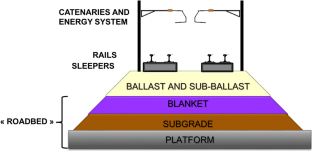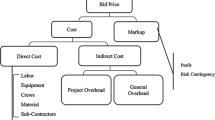Abstract
Purpose
The objective of the study is to progress towards a comprehensive component-based Life Cycle Assessment model with clear and reusable Life Cycle Inventories (LCIs) for high-speed rail (HSR) infrastructure components, and to assess the main environmental impacts of HSR infrastructure over its lifespan, to finally determine environmental hotpots and good practices.
Methods
A process-based LCA compliant with ISO 14040 and 14044 is performed. Construction-stage LCIs rely on data collection conducted with the concessionaire of the HSR line combined with EcoInvent 3.1 inventories. Use and End-of-Life stages LCIs rest on expert feedback scenarios and field data. A set of 13 midpoint indicators is proposed to capture the diversity of the environmental damage: climate change, consumptions of primary energy and non-renewable resources, human toxicity and ecotoxicities, eutrophication, acidification, radioactive and bulk wastes, stratospheric ozone depletion, and summer smog. Three characterization methods are used: the “Cumulative Energy Demand” method to quantify energy demand, the EDIP method for waste productions, and the CML method for the rest.
Results and discussion
The study shows major contributions to environmental impact from rails (10–71%), roadbed (3–48%), and civil engineering structures (4–28%). More limited impact is noted from ballast (1–22%), building machines (0–17%), sleepers (4–11%), and power supply system (2–12%). The two last components, chairs and fasteners, have negligible impact (max. 1 and 3% of total contributions, respectively). Direct transportation can contribute up to 18% of total impact. The production and maintenance stages contribute roughly equally to environmental deterioration (respectively average of 62 and 59%). Because the End-of-Life (EoL) mainly includes recycling with environmental credit accounted for in our 100:100 approach, this stage has globally a positive impact (− 9 to − 98%) on all the impact categories except terrestrial ecotoxicity (58%), radioactive waste (11%), and ozone depletion (8%). Contribution analyses show that if concrete production is one of the important contributing processes over the construction stage, primary steel production is unquestionably the most important process on all the impact categories over the entire life cycle.
Conclusions
These results are of interest for public authorities and the rail industry, in order to consider the full life cycle impacts of transportation infrastructure in a decision-making process with better understanding and inclusion of the environmental constraints. Suggestions are provided in this way for life cycle good practices—for instance as regards gravel recycling choices—and additional research to reduce the impact of current major contributors.








Similar content being viewed by others
References
AFNOR (2014) NF EN 15804+A1 Avril 2014—contribution des ouvrages de construction au développement durable—déclarations environnementales sur les produits—règles régissant les catégories de produits de construction
Åkerman J (2011) The role of high-speed rail in mitigating climate change—the Swedish case Europabanan from a life cycle perspective. Transp Res Part Transp Environ 16:208–217. https://doi.org/10.1016/j.trd.2010.12.004
Albalate D, Bel G, Fageda X (2015) Competition and cooperation between high-speed rail and air transportation services in Europe. J Transp Geogr 42:166–174. https://doi.org/10.1016/j.jtrangeo.2014.07.003
Allacker K, Mathieux F, Pennington D, Pant R (2017) The search for an appropriate end-of-life formula for the purpose of the European Commission Environmental Footprint initiative. Int J Life Cycle Assess 22:1441–1458. https://doi.org/10.1007/s11367-016-1244-0
Asplan Viak AS (2011) New Double Track Line Oslo – Ski Life Cycle Assessment of the Follo Line-Infrastructure, https://www.banenor.no/globalassets/documents/prosjekter/follobanen/lca---folloline-infrastrukture_en.pdf. Accessed 28 Jul 2018
Baker J, Lepech M (2009) Treatment of uncertainties in Life Cycle Assessment. Stanford University, https://web.stanford.edu/~bakerjw/Publications/Baker%20Lepech%20(2009)%20LCA%20uncertainties%20ICOSSAR.pdf. Accessed 30 May 2019
Banar M, Özdemir A (2015) An evaluation of railway passenger transport in Turkey using life cycle assessment and life cycle cost methods. Transp Res Part Transp Environ 41:88–105. https://doi.org/10.1016/j.trd.2015.09.017
Bosquet R, Jullien A, Vandanjon P-O et al (2014) Eco-design model of a railway: a method for comparing the energy consumption of two project variants. Transp Res Part Transp Environ 33:111–124. https://doi.org/10.1016/j.trd.2014.08.003
Bueno G, Hoyos D, Capellán-Pérez I (2017) Evaluating the environmental performance of the high speed rail project in the Basque Country, Spain. Res Transp Econ 62:44–56. https://doi.org/10.1016/j.retrec.2017.02.004
Chang B, Kendall A (2011) Life cycle greenhouse gas assessment of infrastructure construction for California’s high-speed rail system. Transp Res Part Transp Environ 16:429–434. https://doi.org/10.1016/j.trd.2011.04.004
Chester M, Horvath A (2010) Life-cycle assessment of high-speed rail: the case of California. Environ Res Lett 5:014003. https://doi.org/10.1088/1748-9326/5/1/014003
Chester M, Horvath A (2012) High-speed rail with emerging automobiles and aircraft can reduce environmental impacts in California’s future. Environ Res Lett 7:034012. https://doi.org/10.1088/1748-9326/7/3/034012
Chester MV, Ryerson MS (2014) Grand challenges for high-speed rail environmental assessment in the United States. Transp Res Part Policy Pract 61:15–26. https://doi.org/10.1016/j.tra.2013.12.007
CITEPA (2019) Données d’émissions de gaz à effet de serre dans l’air en France métropolitaine, avril 2018, format SECTEN, https://www.citepa.org/images/III-1_Rapports_Inventaires/SECTEN/CITEPA-chiffres-cles-2018-d.zip. Accessed 25 Feb 2019
Civancik-Uslu D, Puig R, Ferrer L, Fullana-i-Palmer P (2019) Influence of end-of-life allocation, credits and other methodological issues in LCA of compounds: an in-company circular economy case study on packaging. J Clean Prod 212:925–940. https://doi.org/10.1016/j.jclepro.2018.12.076
Cour des Comptes (2014) La grande vitesse ferroviaire: un modèle porté au-delà de sa pertinence
D’Alfonso T, Jiang C, Bracaglia V (2015) Would competition between air transport and high-speed rail benefit environment and social welfare? Transp Res Part B Methodol 74:118–137. https://doi.org/10.1016/j.trb.2015.01.007
DELOITTE (2008) Efficacité énergétique et environnementale des modes de transport - synthèse publique. ADEME ; French Ministry of Transportation, https://www.ademe.fr/sites/default/files/assets/documents/51911_synthese-transport.pdf. Accessed 16 May 2019
European Environment Agency (2018) Air quality in Europe — 2018 report. Denmark, https://www.eea.europa.eu/publications/air-quality-in-europe-2018/at_download/file. Accessed 06 Nov 2018
Fries N, Hellweg S (2014) LCA of land-based freight transportation: facilitating practical application and including accidents in LCIA. Int J Life Cycle Assess 19:546–557. https://doi.org/10.1007/s11367-013-0657-2
Häkkinen T, Mäkelä K (1996) Environmental impact of concrete and asphalt pavements. Technical Research Center of Finland, Espoo
Horvath A (2006) Environmental assessment of freight transportation in the U.S. Int J Life Cycle Assess 11:229–239. https://doi.org/10.1065/lca2006.02.244
Horvath A, Hendrickson C (1998) Comparison of Environmental Implications of Asphalt and Steel-Reinforced Concrete Pavements. Transportation Research Record 1626:105–113. https://doi.org/10.3141/1626-13
International Union of Railways (2019) High speed lines in the world (summary), https://uic.org/IMG/pdf/20190328_high_speed_lines_in_the_world.pdf. Accessed 16 May 2019
IPCC (2014) In: Core writing team, Pachauri RK, Meyer LA (eds) Climate change 2014: synthesis report. Contribution of working groups I, II and III to the Fifth Assessment Report of the Intergovernmental Panel on Climate Change. IPCC, Geneva
Jones H, Moura F, Domingos T (2016) Life cycle assessment of high-speed rail: a case study in Portugal. Int J Life Cycle Assess 22:410–422. https://doi.org/10.1007/s11367-016-1177-7
Kirchherr J, Reike D, Hekkert M (2017) Conceptualizing the circular economy: An analysis of 114 definitions. Resources, Conservation and Recycling 127:221–232. https://doi.org/10.1016/j.resconrec.2017.09.005
Le Guern Y, Petiot C, Schloesing E (2011) Mode de prise en compte de la fin de vie lors de la réalisation d’analyses de cycle de vie (ACV) « produits » - Etat de l’Art. Bio Intelligence Service
LISEA (2016) The South Europe Atlantic high-speed line—Paris-Bordeaux in 2 hours—summer 2017
Manche-Nature (2016) Scandaleux traitement au désherbant, la suite. In: Manche-Nat. http://manche-nature.fr/scandaleux-traitement-desherbant-suite/. Accessed 5 Aug 2019
Miyoshi C, Givoni M (2013) The environmental case for the high-speed train in the UK: examining the London–Manchester route. Int J Sustain Transp 8:107–126. https://doi.org/10.1080/15568318.2011.645124
Nicholson AL, Olivetti EA, Gregory JR et al (2009) End-of-life LCA allocation methods: open loop recycling impacts on robustness of material selection decisions. IEEE:1–6
Perl AD, Goetz AR (2015) Corridors, hybrids and networks: three global development strategies for high speed rail. J Transp Geogr 42:134–144. https://doi.org/10.1016/j.jtrangeo.2014.07.006
PricewaterhouseCooper (2016) High speed rail international benchmarking study, https://assets.publishing.service.gov.uk/government/uploads/system/uploads/attachment_data/file/755650/high-speed-rail-international-benchmarkingstudy.PDF. Accessed 05 Aug 2019
Quinet E, et al. (2013) L’évaluation socioéconomique des investissements publics—Rapport final
Ridge L (1998) EUCAR—automotive LCA guidelines—phase 2
Saltelli A, Annoni P (2010) How to avoid a perfunctory sensitivity analysis. Environmental Modelling & Software 25:1508–1517. https://doi.org/10.1016/j.envsoft.2010.04.012
Senat, SNCF-Service environnement (2001) La qualité de l’eau et assainissement en France—Annexe 52—LA S.N.C.F. ET LES PESTICIDES. https://www.senat.fr/rap/l02-215-2/l02-215-246.html. Accessed 5 Aug 2019
Sone S (2015) Comparison of the technologies of the Japanese Shinkansen and Chinese high-speed railways. J Zhejiang Univ-Sci A 16:769–780. https://doi.org/10.1631/jzus.A1500220
Spielmann M, Scholz R (2005) Life cycle inventories of transport services: background data for freight transport. Int J Life Cycle Assess 10:85–94. https://doi.org/10.1065/lca2004.10.181.10
Spielmann M, Bauer C, Dones R (2007) Transport services: Ecoinvent report no. 14. Swiss Centre for Life Cycle Inventories, Dübendorf
Stripple H, Uppenberg S (2010) Life cycle assessment of railways and rail transports - Application in environmental product declarations (EPDs) for the Bothinia Line. Swedish Environmental Research Institute, https://www.ivl.se/download/18.343dc99d14e8bb0f58b75d4/1445517456715/B1943.pdf. Accessed 28 Jul 2018
Svensson N (2006) Life-cycle considerations for environmental management of the Swedish railway infrastructure. Manuscrit de thèse n°1064, Linköping studies in science and technology, Linköping University
The World Bank (2019) Rail lines (total route-km). https://data.worldbank.org/indicator/IS.RRS.TOTL.KM?view=chart. Accessed 16 May 2019
UNPG (2011a) Module d’informations environnmentales de la production de granulats issus de roches massives—données sous format FDES conforme à la norme NF 10-01010. Union Nationale des Producteurs de Granulats
UNPG (2011b) Module d’informations environnmentales de la production de granulats issus de roches meubles - données sous format FDES conforme à la norme NF 10–01010. Union Nationale des Producteurs de Granulats
USAMP/LCA (1998) Life Cycle Inventory of a generic U.S. family Sedan - overview of results USCAR AMP Project. Society of Automotive Engineers, Inc., https://www.sae.org/publications/technical-papers/content/982160/. Accessed 11 Oct 2017
USIRF (2016) Rapport de projet FDES—Analyse de cycle de vie de l’enrobé bitumineux à chaud représentatif français et d’une chaussée en enrobé bitumineux (Document confidentiel). Bio by Deloitte - USIRF
von Rozycki C, Koeser H, Schwarz H (2003) Ecology profile of the German high-speed rail passenger transport system, ICE. Int J Life Cycle Assess 8:83–91. https://doi.org/10.1007/BF02978431
Yue Y, Wang T, Liang S et al (2015) Life cycle assessment of high speed rail in China. Transp Res Part Transp Environ 41:367–376. https://doi.org/10.1016/j.trd.2015.10.005
Zembri P, Libourel E (2017) Towards oversized high-speed rail systems? Some lessons from France and Spain. Transp Res Procedia 25:368–385. https://doi.org/10.1016/j.trpro.2017.05.414
Acknowledgments
We would especially like to express our gratitude to LISEA, the concessionaire of the HSR line, which helped us to collect the data relating to the construction works.
Funding
This work was funded by the chair ParisTech-Vinci “Eco-design of buildings and infrastructures,” a 5-year collaborative research program started in 2008 and renewed in 2013, conducted by Ecole des Ponts ParisTech, Mines ParisTech, and AgroParisTech thanks to the sponsorship of VINCI.
Author information
Authors and Affiliations
Corresponding author
Additional information
Guido W. Sonnemann
Publisher’s note
Springer Nature remains neutral with regard to jurisdictional claims in published maps and institutional affiliations.
Rights and permissions
About this article
Cite this article
de Bortoli, A., Bouhaya, L. & Feraille, A. A life cycle model for high-speed rail infrastructure: environmental inventories and assessment of the Tours-Bordeaux railway in France. Int J Life Cycle Assess 25, 814–830 (2020). https://doi.org/10.1007/s11367-019-01727-2
Received:
Accepted:
Published:
Issue Date:
DOI: https://doi.org/10.1007/s11367-019-01727-2




